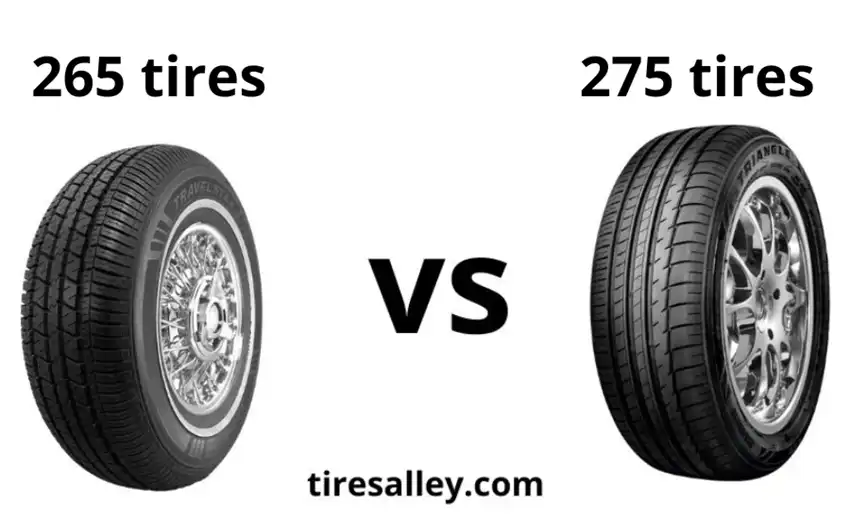Understanding the nuanced difference between 265 and 275 tires is pivotal for motorists seeking optimal performance, safety, and efficiency in their vehicle’s handling and driving experience.
As an expert with years of experience in this field, I will try to explain the topic of 265 vs 275 Tires.
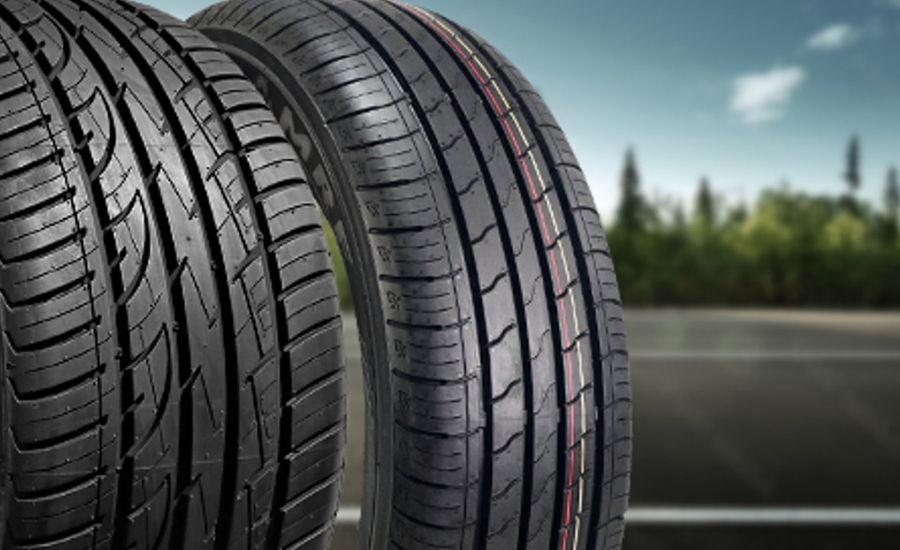
Contents
Factor 1: tire specifications and measurements
265 tire specifications
Section width: the 265 tire typically measures 265 millimeters across the tread.
Aspect ratio: commonly paired with aspect ratios like 70 or 65, indicating the sidewall’s height as a percentage of the tire’s width.
Rim size compatibility: designed to fit specific rim diameters, such as the overall diameter of 17 or 18 inches, ensuring proper installation and compatibility with various vehicles.
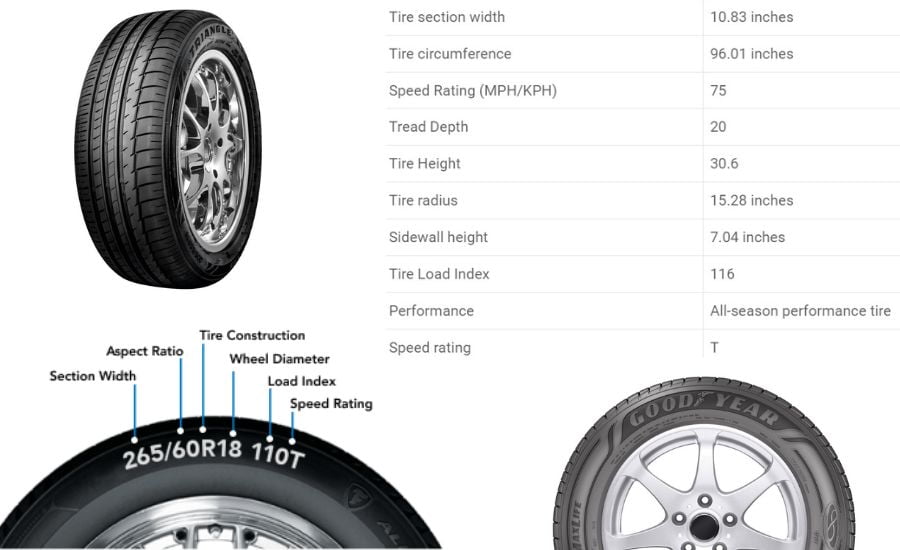
275 tire specifications
Section width: the 275 tire typically measures 275 millimeters across the tread, slightly wider than the 265.
Aspect ratio: often associated with aspect ratios like 70 or 65, offering varying sidewall heights concerning the tire’s width.
Rim size compatibility: similar to the 265 car tires, the 275 tires are designed to fit the same rim size and overall diameter selection, ensuring proper fitting and compatibility with a range of vehicles.
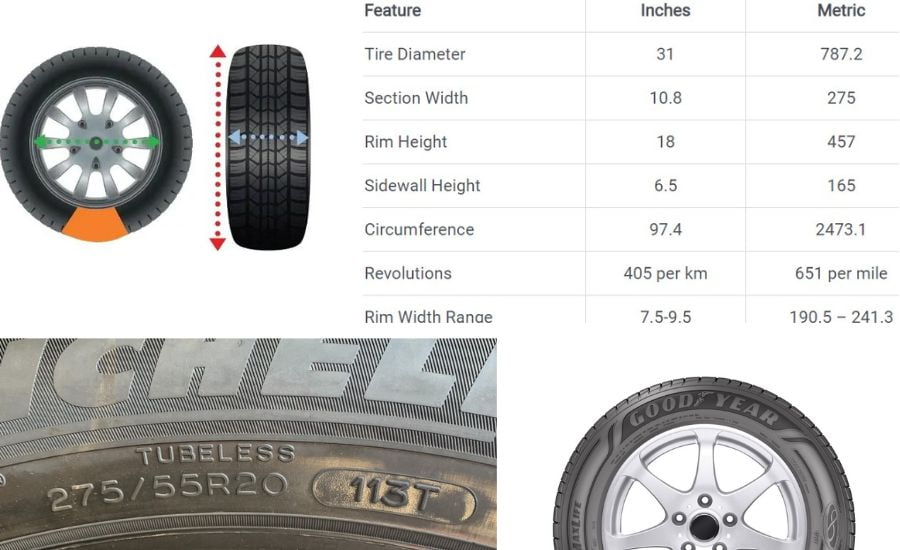
Comparative analysis
Width variation: the primary difference between 265 and 275 tires lies in their section width, with the 275 being a wider (and often taller) tire, while the 265 tires are the thinner tires, which impacts the contact patch and overall grip on the road surface.
Aspect ratio differences: while both tires might share similar aspect ratios, the width discrepancy influences vehicle performance characteristics, affecting wheel clearance, handling, stability, and ride comfort differently.
Considerations for tire selection
Driving preferences: understanding how the width and aspect ratio of these different tires impact performance aids in selecting the right tire size based on individual driving needs, whether prioritizing handling, comfort, or fuel efficiency.
Actual speed: the vehicle’s actual speed will be different. The actual speed is 1.26 mph slower than what the speedometer indicates regardless of the tire size.
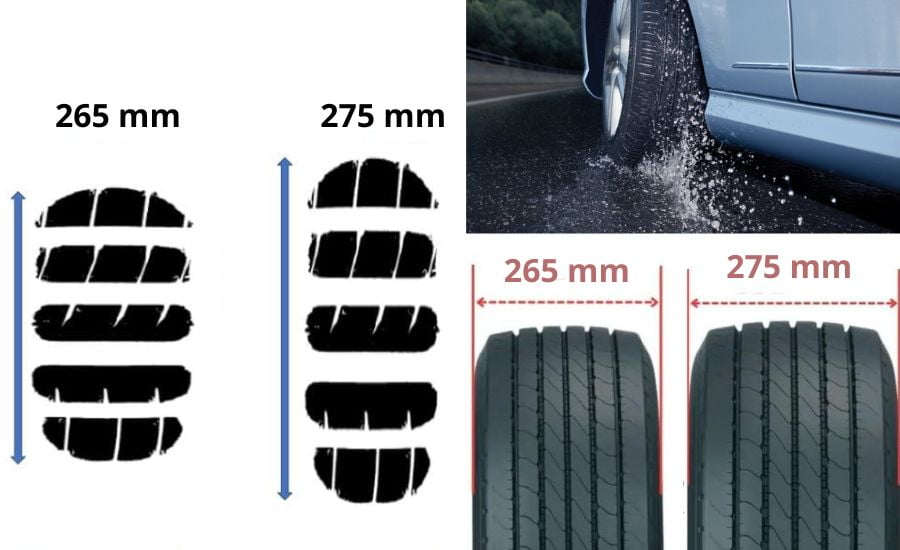
Factor 2: handling and performance of the two tires
265 tire handling characteristics
Responsiveness: the 265 tires, with its comparatively narrower width, often provides responsive handling, especially in city driving and moderate cornering situations.
Maneuverability: due to a slightly smaller contact patch compared to the 275 tire, the 265 might offer slightly sharper maneuverability and steering response in certain conditions.
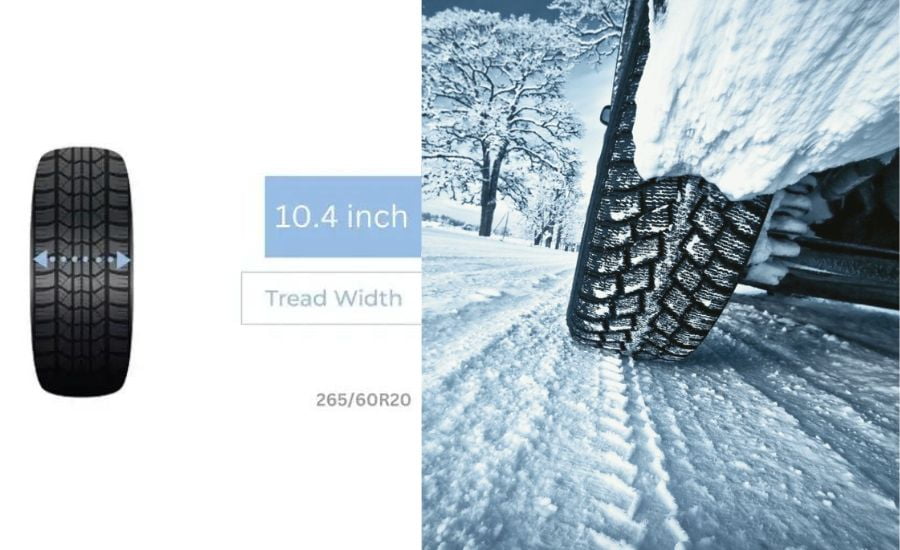
275 tire handling attributes
Stability: the wider footprint of the 275 tires typically offers increased stability, particularly during high-speed driving and aggressive cornering due to their larger contact patch.
Cornering performance: the broader width may enhance cornering capabilities, allowing for better grip and confidence-inspiring handling in a variety of driving situations.
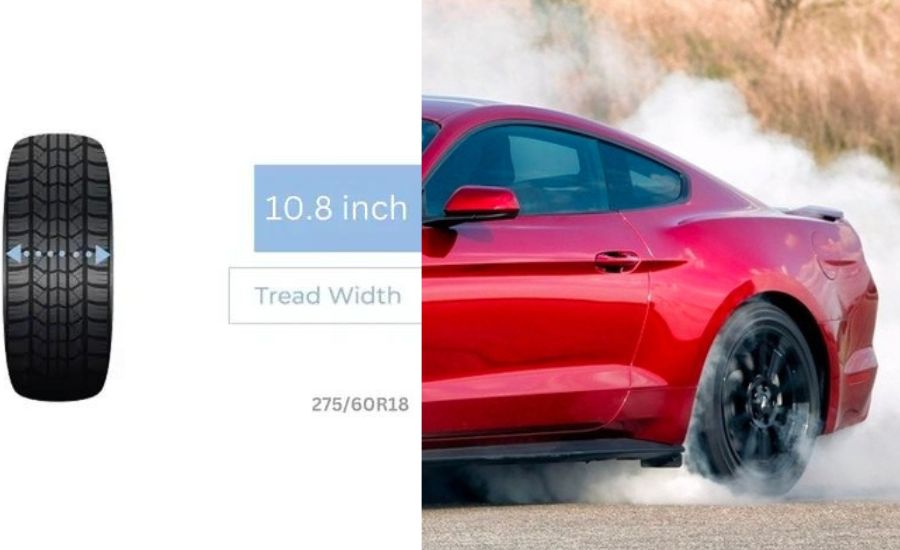
Comparative analysis
Steering response: the 265 tires might exhibit quicker initial steering response due to their narrower width, while the 275 tires could offer more consistent and planted steering throughout turns.
Urban vs. highway driving: the 265 tires might be more suitable for urban environments, offering nimble handling and responsiveness, while the 275 tires could excel on highways, providing stability and confidence at higher speeds.
Considerations for tire selection
Driving conditions: understanding how handling attributes differ between the 265 and 275 tires assists in selecting the right tire size based on specific driving conditions, whether it involves frequent city commuting or long highway journeys.
Performance expectations: identifying the desired balance between handling, stability, and ride comfort helps in making an informed choice between the 265 and 275 tires that aligns with individual maximum performance expectations.
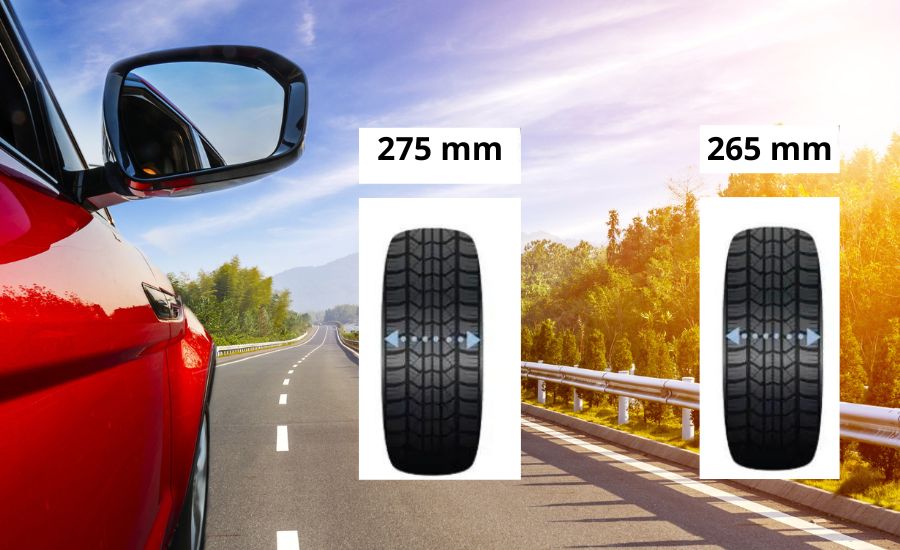
Factor 3: grip and traction of the two tires
265 tire grip and traction
Traction capabilities: the 265 tire, with its narrower width, might offer slightly less traction on various road surfaces, though providing adequate grip in most driving conditions.
Wet and dry performance: in both wet and dry conditions, the 265 tire’s traction might be reliable, though it may vary depending on the tread pattern and rubber compound.
275 tire grip and traction
Better lateral traction: the wider contact patch of the 275 tires often translates to excellent traction, especially during acceleration and braking maneuvers.
Wet and dry surface handling: the broader width might contribute to increased grip on both wet and dry surfaces, potentially offering better confidence in adverse weather conditions.
Comparative analysis
Contact patch impact: the wider footprint and tire pressure of the 275 tires generally result in a larger contact patch, potentially providing superior traction and grip compared to the 265 tire.
Tread design influence: variations in tread design and rubber compounds can influence the grip and traction of both tires, showcasing performance differences beyond width alone.
Considerations for tire selection
Driving style: drivers seeking more aggressive acceleration, improved braking performance, and heightened cornering stability might favor the increased grip potential of the 275 tire.
Environmental conditions: consideration of the predominant weather conditions and road surfaces helps in determining which tire’s traction characteristics better suit the driving environment.
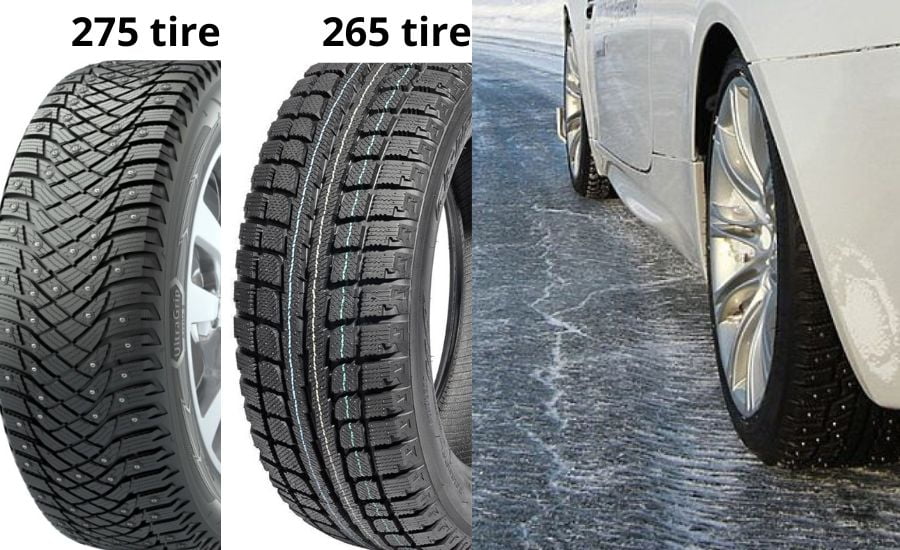
Factor 4: stability of the two tires
265 tire stability
Stability characteristics: the 265 tire, with its narrower width, might offer decent stability, especially during regular driving conditions and moderate speeds.
Handling consistency: while providing adequate stability, the narrower profile might exhibit slightly less stability during high-speed maneuvers compared to wider tires.
275 tire stability
Enhanced stability: the broader width of the 275 tire often translates to increased stability, particularly noticeable at higher speeds and when encountering varying road conditions.
Confidence in handling: the wider footprint contributes to a more planted feel, instilling driver confidence and a sense of stability, especially in situations requiring precise handling.
Comparative analysis
Speed and stability relationship: the wider 275 tire’s enhanced stability at higher speeds might be notably more pronounced compared to the 265 tire, promoting a more secure driving experience on wet and watery roads.
Load-bearing capacity: the broader contact patch of the 275 tire could enhance its ability to support heavier loads, potentially improving overall stability, especially when carrying additional weight.
Considerations for tire selection
Speed and handling preferences: drivers prioritizing stability at higher speeds or seeking a more planted feel might prefer the increased stability offered by the 275 tire.
Load requirements: consideration of load-bearing capacity and the need for enhanced stability under heavier loads helps in choosing between the 265 and 275 tires.

Factor 5: fuel economy and ride comfort
265 tire fuel efficiency
Efficiency considerations: the 265 tire, with its narrower width, might exhibit slightly better fuel efficiency compared to wider alternatives like the 275, primarily due to reduced rolling resistance.
Potential mileage: while the difference might be marginal, the narrower profile could contribute to slightly improved gas mileage, making it a consideration for eco-conscious drivers.
275 tire fuel efficiency
Impact on efficiency: the wider width of the 275 tire might lead to slightly reduced fuel efficiency compared to the 265, as a broader contact patch can increase rolling resistance and, consequently, fuel consumption.
Potential trade-off: while offering enhanced performance, the wider tire might compromise fuel efficiency, albeit the difference might be minimal in everyday driving scenarios.
Comparative analysis
Fuel consumption variances: while the difference might not be substantial, the 265 tire could be marginally more fuel-efficient in day-to-day driving conditions, making it an option for those seeking modest fuel savings.
Ride comfort considerations: the 275 tire’s broader profile might offer a smoother ride due to increased sidewall height, potentially absorbing road imperfections more effectively than the 265 tire.
Considerations for tire selection
Fuel economy priorities: for drivers placing a high emphasis on fuel savings, the marginal advantage in efficiency might steer them toward the 265 tire option.
Comfort preferences: those valuing a smoother and more comfortable ride and maximum performance, especially on rougher surfaces, may find the increased ride comfort of the 275 tire more appealing despite potential differences in fuel efficiency.
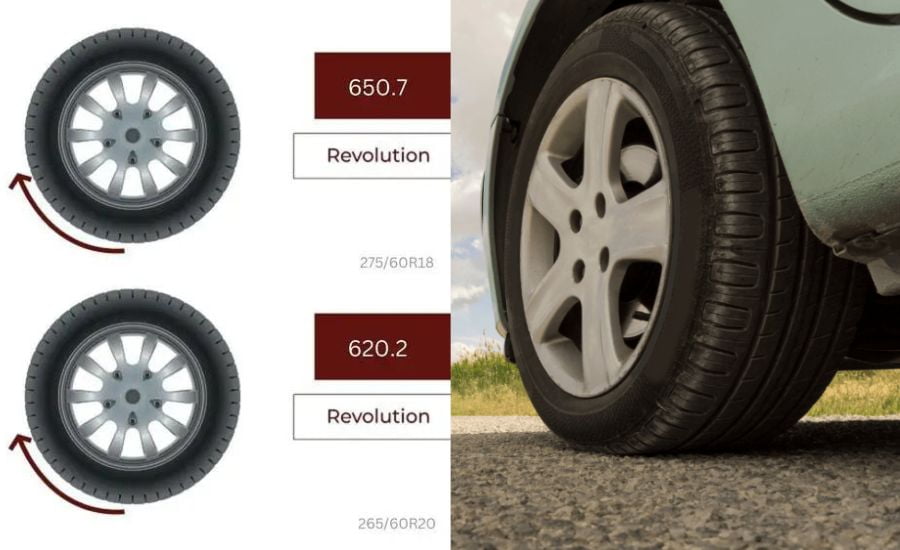
Pros and cons of both tire sizes
Understanding the pros and cons, as well as the difference between 265 and 275 tires, provides valuable insights into their respective strengths and limitations.
Pros and cons of the 265 tire
Pros and cons of 275 tires
Conclusion
In weighing the difference between 265 and 275 tires, selecting the optimal choice hinges upon balancing specific performance and ground clearance needs, environmental considerations, and individual driving preferences.
Ultimately, consulting your vehicle’s manufacturer specifications and considering factors like handling and performance will guide the suitability of switching between tire sizes.
I hope the guide was helpful for you and helped you understand the difference between 275 and 265 tires.
For any questions, be free to write in the questions and I will be glad to answer to everyone!
FAQ
Can I use 275 tires instead of 265?
Yes, you can typically use 275 tires instead of 265 tires, but it’s essential to check your vehicle’s specifications and ensure compatibility.
How much bigger is a 275 70 than a 265 70?
A 275/70 tire is 10 millimeters (approximately 0.39 inches) wider than a 265/70 tire, and 70 refers to the same wheel diameter and the same rims.
Is the 275 in a tire width or height?
The number 275 represents the section width in millimeters, which is approximately 10.83 inches. Check the owner’s manual for the tire’s sidewall height, wheel diameter, and other measurements.
How much bigger is a 285 tire than a 265?
A 285 tire is 20 millimeters (approximately 1.18 inches) wider than a 265 tire.
What do the letters mean in tire size?
A ‘P’ indicates a passenger vehicle.
An ‘LT’ states that the tires are meant for light trucks.
‘ST’ tires are intended for special trailers.

